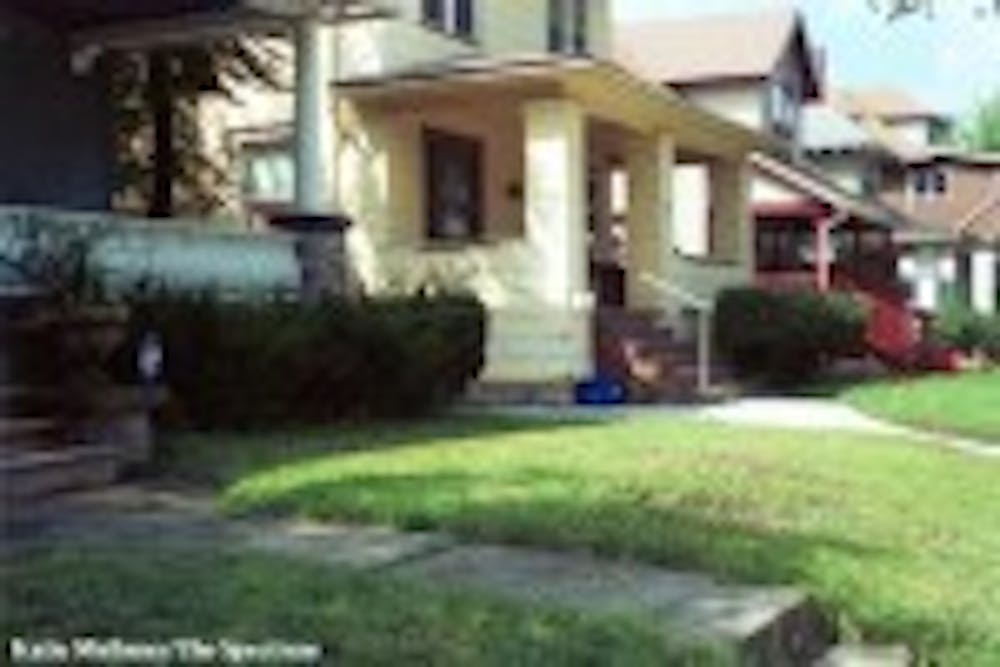Students in the Department of Planning are taking a hands-on approach to studying issues in Buffalo's University Heights area around UB's South Campus, as they research problems and possible solutions for the neighborhood.
Forty-five undergraduates in the "Neighbor-to-Neighbor Studio in Environmental Design" class are undertaking the project along with groups of commercial and community leaders.
"This program is set up to use the neighborhood as a hands on educational experience," said Alex Bitterman, a project director in the Center for Inclusive Design and Environmental Access (IDEA) Center.
"In the past, the Urban and Regional Planning studios have focused on government and public policy," said Bitterman. "This is completely different, (and) a really unique condition that will help the community and the school."
The students have a field office set up in an old storefront on Main Street by the bar Third Base, where the students will be working on the project, holding meetings with the community and conducting their research from this point.
"Essentially, we rented the storefront so students wouldn't be buffered from the area they are working in," said Bitterman. "We want them to be engaged and surrounded by the community."
The first job facing the students was to renovate the vacant storefront, a process that is still underway.
"The storefront we are working out of has been vacant for years. In fact, it was a former meat shop," said Bitterman. "While the students have been cleaning and renovating the space, many passers-by have stopped to look in the windows to see what is going on. It really seems to be piquing the interest of the community."
According to Bitterman, the studio members have been broken up into four groups - one concerned with economic redevelopment, one working on University-community relations, one concerned with the overall aesthetics of the community, and one focused on communication between community groups.
Together, these groups are following a single process, in which all the groups are nearing completion of the first stage.
"Our process has been broken down into three stages," said Bitterman, "First is the precedent work, research as to what other groups have done and to identify issues. Second is to develop that into a field-work exercise, and then to turn that into something deliverable, something that will be in hand, like a proposal for economic development or for garbage collection. There really is a wide range of possibilities."
Bitterman said the university-community relations group, has begun its work by examining the possibility of Campus Cash being used at off-campus businesses in the Heights.
"The students identified this as an issue, and will be surveying businesses and how many of them would be interested in using that program, and conversely, how many students would be interested," Bitterman said.
The Neighbor-to-Neighbor studio is currently working with the 15-member University Heights Community Liaison Group, consisting of area residents and other commercial, government and community groups.
While the Main Street businesses have representation in the studio's community meetings, no individual businesses have taken part in the proceedings yet.
Bitterman said he hopes more interest will be generated as the studio raises its profile through advertising and increased community awareness.
Main Street is not the only area around South Campus that is being investigated - students are also looking into development possibilities on Bailey Avenue, which also borders South Campus.
"There really isn't a business district or group from the Bailey Avenue corridor, so they are currently underrepresented," said Bitterman. "That is a condition we are working to fix through our programs."
The Neighbor-to-Neighbor Studio has generated a lot of interest from UB administration, according to Bitterman.
"Believe it or not, the idea for this whole program started with President (William) Greiner suggesting the study to Kate Foster (director of UB's Department of Planning) this summer," said Bitterman. "He suggested it as an idea, and Kate just ran with it. I think it's a remarkable example of how no-nonsense people can get things done quickly."
Some students said they wonder if the university can address problems in the area by itself.
"I think it has more to do with the City of Buffalo rather than the university," said Constantine James, a senior marketing major and former resident of Northrup Place. "Though if they work side by side, they may actually get something done."





